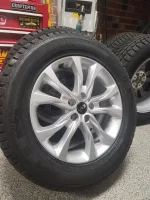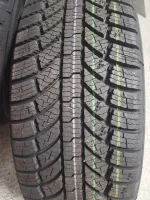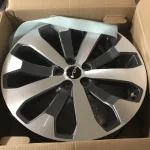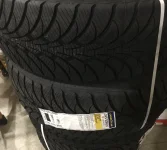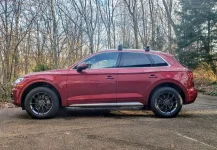Anyone with snow tire sizing recommendations for a 2022 SX? I know I am going with Blizzaks just not sure of the size. When I called American Tire they recommended staying with the 20 inch tires, but reading online says better to go a size down. Anyone here with experience and recommendations on snow tire sizing?
-
Hint: Use a descriptive title for your new message
If you're looking for help and want to draw people in who can assist you, use a descriptive subject title when posting your message. In other words, "I need help with my SUV" could be about anything and can easily be overlooked by people who can help. However, "I need help with my transmission" will draw interest from people who can help with a transmission specific issue. Be as descriptive as you can. Please also post in the appropriate forum. The "Lounge" is for introducing yourself. If you need help with your leather interior, please post in the Interior section - and so on... This message can be closed by clicking the X in the top right corner. -

You are using an out of date browser. It may not display this or other websites correctly.
You should upgrade or use an alternative browser.
You should upgrade or use an alternative browser.
Snow Tire Recommendations
- Thread author Ski99
- Start date
DarkMossJustin
Well-known member
Do you have a set of 18" rims for the Blizzaks?
PittPa
Well-known member
Stick with 18", the only advantage of 20" is if you are not changing rims. I purchased these used telluride rims off ebay and mounted General Grabber Artic. They were rated well. I was going to plasti dip them but they are in such great shape probably not.
Attachments
Last edited:
2XrovernowKIA
New member
- Joined
- Jul 12, 2021
- Messages
- 27
- Reaction score
- 8
- Points
- 3
What are the stock 20’s that come on the SX like in the snow? Drive in the northeast and never have I changed to snow tires. Isn’t he 4x4 mode enough?
______________________________
byscott
Often Wrong, Rarely Uncertain ;-)
I live on top of a hill and have run snow tires on several 4WD and AWD vehicles. My last three sets of snows were all Blizzaks — one thing to remember with Blizzaks is that at about 6/32 they’re more like an all-season tire than a snow tire. That’s why they have two sets of wear bars … when you hit the first set, the tire will still pass inspection but its snow effectiveness is diminished.
According to Bridgestone this is pretty much the case with all snow tires. I don’t know if that’s true or if it’s a savvy marketing ploy.
On my last two SUVs (Honda Pilot and Acura MDX), I ran my snow tires on wheels one inch smaller than my all-seasons. The rationale for this is that the snow tires are slightly narrower than the summer tires, which is what you want in the winter.
The Telluride is a bit different in that the OE 18” size has exactly the same width (245mm) as the OE 20” size. If you want a slightly narrower snow tire, you could go with a 235/65-18, which would be just a bit taller overall and would induce fairly minimal speedometer error.
I had planned on going the same route as PittPa and picking up a set of OE 18” wheels but couldn’t resist a very nice set of OE 20” wheels being sold by a forum member. I had also planned on Blizzaks but ran across a stupidly good price on Goodyear Ultra Grip Ice WRTs in 245/50-20 (the OE 20” size). My wife had these on an Infiniti G37x and they were good enough for several trips to, from, and around Buffalo in the dead of winter. IMO not as good as the Blizzak but probably 85 - 90% of Blizzak performance at ~50% of the cost. I’m retired, so if it gets really bad I just stay home
According to Bridgestone this is pretty much the case with all snow tires. I don’t know if that’s true or if it’s a savvy marketing ploy.
On my last two SUVs (Honda Pilot and Acura MDX), I ran my snow tires on wheels one inch smaller than my all-seasons. The rationale for this is that the snow tires are slightly narrower than the summer tires, which is what you want in the winter.
The Telluride is a bit different in that the OE 18” size has exactly the same width (245mm) as the OE 20” size. If you want a slightly narrower snow tire, you could go with a 235/65-18, which would be just a bit taller overall and would induce fairly minimal speedometer error.
I had planned on going the same route as PittPa and picking up a set of OE 18” wheels but couldn’t resist a very nice set of OE 20” wheels being sold by a forum member. I had also planned on Blizzaks but ran across a stupidly good price on Goodyear Ultra Grip Ice WRTs in 245/50-20 (the OE 20” size). My wife had these on an Infiniti G37x and they were good enough for several trips to, from, and around Buffalo in the dead of winter. IMO not as good as the Blizzak but probably 85 - 90% of Blizzak performance at ~50% of the cost. I’m retired, so if it gets really bad I just stay home
Attachments
PittPa
Well-known member
Yes and no. I used the stock 20 with the all seasons last winter. My wife drives a Q5 with dedicated snows and when it came down, the difference was very apparent. The biggest problems I had with the Telly was stopping in the snow with the all seasons. We have a long uphill driveway and sometimes I don't have time to clear it. I can make it up no problem but its a white knuckler coming down. It was an adventure. I am of the mind set that with all wheel drive, good weight distribution and good ground clearance, any decent snow tire will give you more than enough traction and stopping power. There are nuances in the ratings like dry and wet weather handling, noise, wear, etc that I wasn't too concerned about. Just performance in snow. I got the General Grabber at Discount Tire for a great price. They matched Amazon's price @$128 each for 245/60 R18 along with a $100 gift card to boot.What are the stock 20’s that come on the SX like in the snow? Drive in the northeast and never have I changed to snow tires. Isn’t he 4x4 mode enough?
Last edited:
PittPa
Well-known member
I really do like those wheels! I would say the only downside to winter wheels is they aren't as nice as the OE ones. I bought these for my wife from Tirerack and they look fine, gives the car a purposeful pose. With the ones I will use, I guess I will see how it looks.I live on top of a hill and have run snow tires on several 4WD and AWD vehicles. My last three sets of snows were all Blizzaks — one thing to remember with Blizzaks is that at about 6/32 they’re more like an all-season tire than a snow tire. That’s why they have two sets of wear bars … when you hit the first set, the tire will still pass inspection but its snow effectiveness is diminished.
According to Bridgestone this is pretty much the case with all snow tires. I don’t know if that’s true or if it’s a savvy marketing ploy.
On my last two SUVs (Honda Pilot and Acura MDX), I ran my snow tires on wheels one inch smaller than my all-seasons. The rationale for this is that the snow tires are slightly narrower than the summer tires, which is what you want in the winter.
The Telluride is a bit different in that the OE 18” size has exactly the same width (245mm) as the OE 20” size. If you want a slightly narrower snow tire, you could go with a 235/65-18, which would be just a bit taller overall and would induce fairly minimal speedometer error.
I had planned on going the same route as PittPa and picking up a set of OE 18” wheels but couldn’t resist a very nice set of OE 20” wheels being sold by a forum member. I had also planned on Blizzaks but ran across a stupidly good price on Goodyear Ultra Grip Ice WRTs in 245/50-20 (the OE 20” size). My wife had these on an Infiniti G37x and they were good enough for several trips to, from, and around Buffalo in the dead of winter. IMO not as good as the Blizzak but probably 85 - 90% of Blizzak performance at ~50% of the cost. I’m retired, so if it gets really bad I just stay home
Attachments
100% I need dedicated snow tires. Makes a huge difference. I think I'll just stick with the rims I have and get the same 20 inch Blizzaks, unless anyone thinks that is a huge mistake.
______________________________
Numbersguy
Active member
- Joined
- Jul 13, 2021
- Messages
- 179
- Reaction score
- 118
- Points
- 43
Like a previous member wrote, if you don't plan on mounting your snow tires on separate rims then go with the 20'. It will be cheaper if you downsize to 18'. I'm going with 235 65 R18 because I want a narrower footprint on the pavement and increase weight on the tire for greater traction. The tire I'm getting it is the Yokohama Iceguard G075, its gotten good reviews for snow and ice traction.
byscott
Often Wrong, Rarely Uncertain ;-)
@PittPa … that’s a great price!
@Ski99 … maybe worth checking with local tire places and getting a feel for the cost of mounting/balancing tires a couple times per year vs. the cost of buying a second set of wheels and tire pressure sensors and just having to mount/unmount wheels.
My local outfit, IIRC, is ten bucks a wheel to mount/unmount and $25 for mount & balance. So, $80/year to change out tires if they’re on wheels, $200/year otherwise. Over four or five years it’s probably a wash. A second set of wheels might actually be more economical if you change them yourself (which I used to do until I got lazy ;-).
@Ski99 … maybe worth checking with local tire places and getting a feel for the cost of mounting/balancing tires a couple times per year vs. the cost of buying a second set of wheels and tire pressure sensors and just having to mount/unmount wheels.
My local outfit, IIRC, is ten bucks a wheel to mount/unmount and $25 for mount & balance. So, $80/year to change out tires if they’re on wheels, $200/year otherwise. Over four or five years it’s probably a wash. A second set of wheels might actually be more economical if you change them yourself (which I used to do until I got lazy ;-).
PittPa
Well-known member
I have done it both ways. Since you are going to have to store them either way, thats a wash. Your paying more for 20" tires vs 18" I jack up my car and do it myself which may take an hour out of my time, no biggie. What I really like it that you are not continually mounting and balancing tires every year. If you have a great mounted tire with no vibrations, I hate to change that. Plus the wear on your rims with the continually mounting, dismounting, and balancing. I just look at the forecast, any sign of winter coming I just do it.
I just bought this recently, so no need to even use my air compressor.
I just bought this recently, so no need to even use my air compressor.
Numbersguy
Active member
- Joined
- Jul 13, 2021
- Messages
- 179
- Reaction score
- 118
- Points
- 43
That's a point I wanted to make as well, my tire guy says that continually mounting tires on the same rims does cause wear and may lead to slow leaks around the rim because the seals become weak over time due to the constant changing.I have done it both ways. Since you are going to have to store them either way, thats a wash. Your paying more for 20" tires vs 18" I jack up my car and do it myself which may take an hour out of my time, no biggie. What I really like it that you are not continually mounting and balancing tires every year. If you have a great mounted tire with no vibrations, I hate to change that. Plus the wear on your rims with the continually mounting, dismounting, and balancing. I just look at the forecast, any sign of winter coming I just do it.
I just bought this recently, so no need to even use my air compressor.
______________________________
^^^this is the only way i would do it...i wouldn't want to go through the hassle and expense of swapping tires out on the same wheels each season...i was thinking of getting my wife snow tires and wheels for her new '22...we live in the northeast on the coast...may just see how it handles this winter in the snow and go from there...i drive a subaru with all season tires that handles good enough for me so i don't swap tires/wheels...never run snow tires so i don't really know what i'm missingI have done it both ways. Since you are going to have to store them either way, thats a wash. Your paying more for 20" tires vs 18" I jack up my car and do it myself which may take an hour out of my time, no biggie. What I really like it that you are not continually mounting and balancing tires every year. If you have a great mounted tire with no vibrations, I hate to change that. Plus the wear on your rims with the continually mounting, dismounting, and balancing. I just look at the forecast, any sign of winter coming I just do it.
I just bought this recently, so no need to even use my air compressor.
where can i find the bolt pattern and specs for the '22 OEM telluride wheels?
Last edited:
Numbersguy
Active member
- Joined
- Jul 13, 2021
- Messages
- 179
- Reaction score
- 118
- Points
- 43
Try this sitewhere can i find the bolt pattern and specs for the '22 OEM telluride wheels?
Kia Telluride Wheel Size and Specs
With the Kia Telluride wheel size chart, users can quickly figure out the effects of changing the offset and wheel width. Start by entering your current bolt pattern, wheel width, and offset. Then specify the new wheel's width and offset to determine the clearance between the strut housing and...
WGtelly2022
Member
- Joined
- Jun 23, 2021
- Messages
- 36
- Reaction score
- 17
- Points
- 8
Pardon my lack of my knowledge on snow tires.
What is advantage of switching to snow tires when I have all weather tires already on my telly ? I live in Denver metro area, we get decent amount of snow but Sun comes next day and cleans most of it.
comes next day and cleans most of it.
I used to have Audi Q5 with all weather tires and i never changed to snow tires, it worked well for me, What I am missing ?
What is advantage of switching to snow tires when I have all weather tires already on my telly ? I live in Denver metro area, we get decent amount of snow but Sun
I used to have Audi Q5 with all weather tires and i never changed to snow tires, it worked well for me, What I am missing ?
PittPa
Well-known member
Here is Western PA, we get a decent amount of snow, but the sun may not come out for months! Lots of hills.
______________________________
Numbersguy
Active member
- Joined
- Jul 13, 2021
- Messages
- 179
- Reaction score
- 118
- Points
- 43
All season tires have a tread pattern that is good for wet and dry conditions for warmer temperatures. Once the temperatures drop consistently below 43 F, the tread compound stiffens and loses its flexibility in colder weather. Also the tread depth is not as deep as winter tires and after riding on them constantly tire wear will make navigating deep snow and ice more treacherous. Siping in all-season tires dissipates heat and offers some added traction in wet conditions.Pardon my lack of my knowledge on snow tires.
What is advantage of switching to snow tires when I have all weather tires already on my telly ? I live in Denver metro area, we get decent amount of snow but Suncomes next day and cleans most of it.
I used to have Audi Q5 with all weather tires and i never changed to snow tires, it worked well for me, What I am missing ?
Winter tire tread compound remains flexible in colder temperatures below 43 F, the design of the tread pattern is such that it can remove a large volume of snow beneath the tires by having deeper grooves and irregular sharper edges and allow it to make contact with the pavement. Winter tires will typically have more siping to maximize grip in winter-driving conditions providing grip on ice that allow for greater stopping ability and start up.
In the end, the decision is a personal one and must be dependent on the type of weather you normally get and places you frequent. If you don't get a lot of ice and snow and temperatures are above 43 F most times, then all seasons may work.
WGtelly2022
Member
- Joined
- Jun 23, 2021
- Messages
- 36
- Reaction score
- 17
- Points
- 8
Thanks for explaining in details.All season tires have a tread pattern that is good for wet and dry conditions for warmer temperatures. Once the temperatures drop consistently below 43 F, the tread compound stiffens and loses its flexibility in colder weather. Also the tread depth is not as deep as winter tires and after riding on them constantly tire wear will make navigating deep snow and ice more treacherous. Siping in all-season tires dissipates heat and offers some added traction in wet conditions.
Winter tire tread compound remains flexible in colder temperatures below 43 F, the design of the tread pattern is such that it can remove a large volume of snow beneath the tires by having deeper grooves and irregular sharper edges and allow it to make contact with the pavement. Winter tires will typically have more siping to maximize grip in winter-driving conditions providing grip on ice that allow for greater stopping ability and start up.
In the end, the decision is a personal one and must be dependent on the type of weather you normally get and places you frequent. If you don't get a lot of ice and snow and temperatures are above 43 F most times, then all seasons may work.
Oddiew
Member
- Joined
- Jul 16, 2021
- Messages
- 81
- Reaction score
- 28
- Points
- 18
Alot of people are checking out the Michelin crossclimate2 for high performance all weather.
Has rave reviews and fits certain population well. Is 3 peak snowflake rated. Check out any review.
- don't experience severe wintry conditions? Don't want to?
- don't want to swap snows and all seasons per year? Just rotate?
- don't have space to store a set of tires?
- just leave them on your Telly 24/7?
This is the tire for you.
Has rave reviews and fits certain population well. Is 3 peak snowflake rated. Check out any review.
- don't experience severe wintry conditions? Don't want to?
- don't want to swap snows and all seasons per year? Just rotate?
- don't have space to store a set of tires?
- just leave them on your Telly 24/7?
This is the tire for you.

